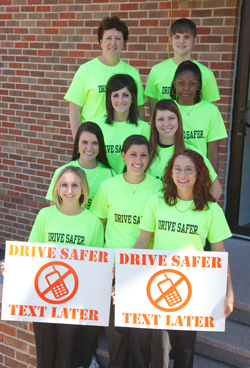Nursing students look to curb texting trend
On the home page:
Click on the thumbnail for a larger picture.
Senior nursing student Christina Donze is interviewed by reporter Doug Mouton of WWL-TV,
New Orleans, on the project she and other Southeastern nursing students adopted to
help limit texting and driving among teenagers.
Christina Donze, senior nursing student
Terry Compton, RN, MS, nursing instructor
While it’s illegal in an increasing number of states – Louisiana included – and the
statistics clearly show the dangers, many drivers continue to use their cell phones
to text messages. And the habit is especially prevalent among teenage drivers.
The fact that texting while driving is equivalent to driving with an .08 blood alcohol level and personal knowledge of a 19-year-old who lost control of her vehicle and was killed while texting, prompted a group of Southeastern nursing students to look further into the problem. Christina Donze and seven other nursing students selected the practice for their Capstone project, a community outreach research course required of all senior nursing students at Southeastern.
 |
|
Southeastern nursing students involved in a project to try to decrease teen texting while driving included, from left, front row, Elizabeth Jenkins, Kayla Rebaldo and Kristine Bourlet; second row, Brittany Sessions and Amanda Lusk; third row, Christina Donze and Keremeche Brown; fourth row, nursing instructor Terry Compton and student Chad Wilson. |
The team delved into researching the topic and came up with a number of interesting
points:
• 80 percent of crashes and 65 percent of near crashes are caused by driver inattention
within three seconds of the event;
• Drivers who use cell phones are four times as likely to get into serious crashes
compared to those who don’t;
• 62 percent of high school drivers say they can talk on a cell phone while driving,
and 24 percent believe it is safe.
Their field research including doing “windshield surveys,” in which the student nurses
stationed themselves near area high schools to see how many students appeared to be
texting while driving as they pulled into and left the school grounds. Based on that
study, they decided to focus their educational program on the students at Fontainebleau
High School in Mandeville.
Donze said the windshield survey showed that approximately 40 percent of the students
at Fontainebleau were either texting or talking on a cell phone while driving in the
morning. A pre-survey conducted with the students indicated that 80 percent admitted
to texting while driving; 80 percent of the respondents also admitted they knew the
practice was dangerous.
The educational program, called “Drive Safer-Text Later,” was geared to the junior
and senior high students at Fontainebleau and included a presentation by a state trooper,
a PowerPoint presentation on the facts by the nursing students, a short video, and
a personal testimonial by the aunt of a young person who had been killed while driving
and texting. The students also worked with a local billboard company to post a free
advertisement with the theme “Is any text worth dying over … don’t text and drive”
and appeared on several radio and TV programs about the problem. Their project was
featured in the Hammond Daily Star and the New Orleans Times Picayune.
The presentation did have an immediate impact. A follow-up survey conducted with students
attending the presentation revealed that 45 percent of the students had not texted
while driving one week later and another 37 percent said they greatly decreased the
amount of texting while driving.
“We know some of these students will continue to text while driving,” said nursing
student Amanda Lusk. “We were just hoping to make some impact on them; I believe we
did.”
“The students were very invested in this project,” said Southeastern instructor Terry
Compton. “Once they realized how prevalent this problem had become, they took ownership
of it, set their goals and overcame any obstacles or barriers they faced. I’m very
proud of them and the tremendous effort they put into this project. It definitely
had an impact.”
More Homepage Stories...

